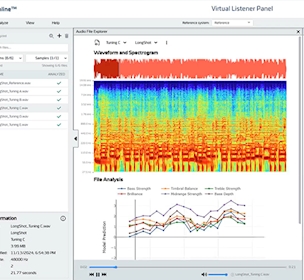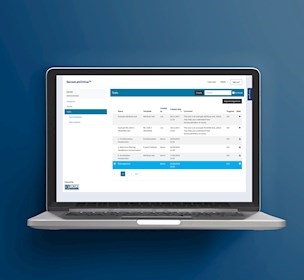Compare noise levels on the noise scale
The noise scale shows the noise levels generate by a variety of sources under specified conditions. You can use it to visualise and compare noise levels, which are ordered by loudness.
For many years, FORCE Technology has been documenting noise levels from a variety of sources. Some of the sources are listed on the noise scale as examples of typical noise levels.
Many other noise scales have been produced, but FORCE Technology's scale is based on well-documented measurements.
From the hearing threshold to the pain threshold
The noise scale runs from 0 dB(A), which is the approximate threshold of hearing for someone with normal hearing, up to the threshold of pain, which is at approximately 120 dB(A).
A noise level of 0 dB(A) does not mean that there is absolutely no noise, but that the noise level is so low as to be inaudible to most people. From a distance of one metre, a person speaking at a normal volume will typically be heard at or slightly above 60 dB(A).
Air raid sirens can be found at the top of the noise scale. They need to be heard by everyone. From a distance of 30 metres, they can typically be heard at noise levels near 120 dB(A). Clubs, outdoor rock concerts, and aeroplane ignition sequences are examples of other very loud noise sources.
Time, weather, and space
The noise limit for work environments is 85 dB(A) measured over eight hours, but hearing protection is required for noise levels above 80 dB(A) to avoid hearing damage. The eight-hour measurement period is an inseparable part of the noise limit, so brief exposures to 85 dB(A) are not necessarily harmful to hearing.
At the low end of the noise scale, we can see that a quiet bedroom has a noise level of about 20-25 dB(A), and comparable noise levels can be experienced in a quiet forest with little to no wind. The noise level is greater in windy conditions - typically at or above 60 dB(A) with winds at 8 m/s.
Outdoor noise levels depend on the weather (including the wind) and the particular environment in question. Most of us have probably noticed that a busy road sounds noisier downwind than it does upwind (relative to the road and the listener).
Indoor noise levels depend on whether surfaces in the room absorb or reflect sound waves. For instance, a vacuum cleaner sounds quieter in a carpeted, densely furnished room than it does in a sparsely furnished room with stone walls and tiled floors.
Sound power versus noise level
Note that the sound levels listed for household appliances and similar products are not the same as the noise levels reported by a sound pressure metre.
Standards for product declarations require documentation of sound power levels, and these numbers are typically greater than the products' corresponding noise levels.
Noise level versus noise annoyance
The noise scale shows noise levels as measured by a sound pressure metre. However, these numbers do not necessarily indicate the degree to which each noise would be considered bothersome.
Sources that produce equal noise levels (as measured in dB(A)) can still be bothersome to different degrees. For instance, wind turbine noise is more bothersome than railway noise at the same noise level. Sources of very low-frequency noise can also be more irritating than sources of more spectrally balanced noise (i.e., roughly even levels of high and low frequencies). AS a result, FORCE Technology has developed a separate scale for low-frequency noise, here meaning noise at frequencies between 10 and 160 Hz, measured in dB(A)-LF.
Accredited Notified Body
FORCE Technology tests and documents noise and vibration from machines. We are an accredited Notified Body for machine noise measurements needed for CE marking, and we are accredited by DANAK for noise and vibration measurements.
You are welcome to use this noise scale as a reference, provided that you credit FORCE Technology.
Download the noise level comparison chart

How five OTC hearing aids perform in realistic settings
/Service

Objective audio quality measurements made simple
/Service
Obtain electroacoustic measurements like frequency response, ANC, POLQA, and AI-driven metrics.

Virtual Listener Panel™: AI-driven sound quality tool
/Service
Get perceptual characterisation of audio products anytime with VLP's AI evaluations.

Report: Midrange true wireless earbuds
/Service
Unbiased audio benchmark reports help tech, marketers and users compare sound excellence.

Report: Premium Bluetooth Speakers
/Service
Unbiased audio benchmark reports help tech, marketers, and users compare sound excellence.

SenseLab Quality Rating Report 3.0 Light: earbuds
/Service
Earbud excellence unveiled: Explore top-rated audio.

Sound Wheel: Unifying sound perception
/Service
Enhance communication and evaluation of sound and get a common language in audio perception.

Fast and reliable listening tests with SenseLabOnline
/Service
Easy-to-use, complete online listening facility with recognised standards for audio product testing.

Low Noise Speaker Spinners optimise sound evaluation
/Service
Efficient testing with Low Noise Rapid Speaker Spinners. Optimise your speaker assessments.

HOA-SSR Dataset: Sound Scene Library
/Service
Evaluate sound excellence for comprehensive audio product development.


